Earth Sciences in Conversation: Phil Holdship

Our Earth Sciences in Conversation series explores the lives and careers of members of the Department, showing readers the people behind our world-leading research. For this issue we sat down with Phil Holdship, Research Fellow and ICP-MS Lab Manager, to learn more about his work at the forefront of mass spectrometry, doing a DPhil part-time, and tackling anaemia with analytical chemistry.
Interview by Charlie Rex
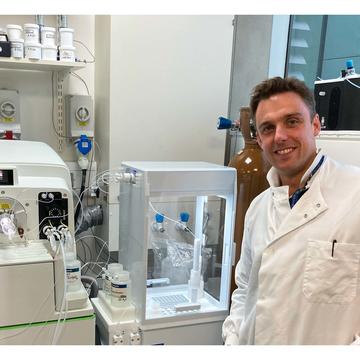
What (or who) inspired you to get into Earth Sciences?
This goes back quite a few years now, but when I was growing up, I was always really interested in science, particularly the weather. So, when I was doing my GCSEs and A Levels, I focussed more on physics, with an aim to study Meteorology at the University of Reading. However, I then became really interested in climate change and the environment – this was in the late 90s – and ended up pursuing Environmental Geology for my undergraduate degree.
You've had a really interesting career path so far. Tell us more about your Earth Sciences journey.
I studied at Aberystwyth in Wales. My undergraduate course began as Environmental Geology, but then changed to Earth Sciences within my first year. I really enjoyed the course, particularly learning about all of the dynamic earth processes, because I didn't study geology at A Level. I had an interest in physics at school, but during my undergrad I found myself moving towards more of the chemistry side, particularly analytical chemistry. So, I took that forward after my BSc to do a masters, again at Aberystwyth, in Environmental Geosciences. There was some geophysics in there as well, but the main focus was geochemistry. That was in the early 2000s, and after that I had some time out of studying and decided to move away from academia – I went travelling around New Zealand. When I got back, I was offered a job at Harwell working in a contract laboratory, which brought me to Oxfordshire. During my undergrad and masters we were lucky to have access to an ICP-MS [inductively coupled plasma mass spectrometer], so I had already done some work on that type of instrument. I worked in both ICP and clean labs at Harwell for around six years, before switching route back to academia in 2010, when I joined Oxford Earth Sciences as a lab manager.
You’ve spent a large portion of your career working with ICP-MS and other analytical techniques – can you tell us why you find them so interesting?
Because ICP is really cool! We use it to measure almost the whole periodic table, which is fascinating. The world of mass spectrometry really interests me, particularly when adapting it to measure things that would have previously been impossible. I’ve been working on this technique for a long time, but it’s so powerful and there’s always something new and exciting to try. We’re working with vacuum levels that are the same as in the middle of deep space, and at high voltages for particle acceleration. When these are coupled together it is allowing us to push the boundaries of science. ICP is the endeavour to measure the world of the unknown – we aren’t using it to measure the most abundant elements, rather those contained at the tiniest proportions. In our department, this can give us a lot of detail about the type of environment or even the biology of the thing we are measuring. Each sample is different, and it’s really interesting to analyse each one.
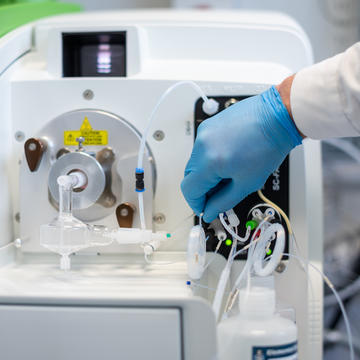
What was your first experience with ICP-MS?
During my masters project we went to a mine in Anglesey, which looked like a Martian landscape because it was all bright orange. I remember it being an extremely preserved opencast site, where copper had been excavated since as early as the bronze age. At one point it was also the largest copper mine in the world, and more recently used as a filmset for the film – Planet of the Apes. However, the site is also really contaminated – particularly with arsenic, which led us to examine many geochemical samples for levels of many metal pollutants by ICP-MS. The landscape surrounding the site is undergoing restoration, so our aim was to investigate the amount of heavy metals that were being deposited into nearby watercourses.
You’re currently working on a DPhil part-time alongside your lab manager role. How did that come about?
It’s quite a funny story! My supervisors Jon and Hal met at a BBQ which was for their wives. They started chatting about football and then moved onto talking about their research. Jon is a planetary scientist and Hal is a biologist, but both of them work on iron – its role in how life formed, and in the human body, respectively. It transpired that up the hill at the Weatherall Institute, they are really interested in being able to measure metals in individual cells, and iron was of deep interest. So, Hal asked Jon if there was a way to measure iron in a single cell using the highly sophisticated instrumentation that we have in our department, and Jon said “I’ll ask Phil, who runs the ICP-MS here”. I had been at a seminar recently about the topic, and I thought there was a way we can adapt the instrument we have here in the department to perform that process. They successfully applied for a grant to cover the equipment modifications, and then Jon suggested it would be a good way for me for me to tie-in doing a DPhil part-time (he worked really hard to make it happen!). It was a long process from start to finish, but it all started with a BBQ!
Tell us what your DPhil research is about?
We are trying to understand iron biology better at the molecular and atomic level. There has been a lot of work over the years to try to better understand conditions like anaemia more, which is a condition linked to poor iron absorption in the body. Anaemia is a real global health problem, not only in the UK, but particularly in middle-income countries in Africa and Southeast Asia. A lot of money has been spent to try and understand this, but in many ways it has failed, because of many reasons, but particularly due to a gap in knowledge in iron’s utilisation in the body at the atomic level, which we haven’t had the capability to investigate. Mass spectrometry is allowing us to measure the iron levels in many cells, including T-cells, which are a key part of the immune system. To increase our understanding in this crucial area we are using our ICP mass spectrometers to measure iron on a scale of a billionth of a billionth of a gram, which wouldn’t be possible by any other technique. On top of this, we are also aiming to measure the cells really quickly, to scan a whole series of cells in a population within a minute or so, which is really cool.
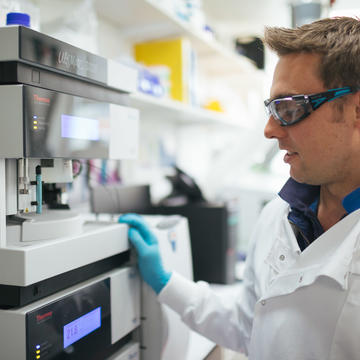
Phil operating one of the Department's HPLC instruments
What has your experience been like collaborating across scientific disciplines?
It’s really been really positive. As I mentioned before, I focussed on physics at school and then made the move over to chemistry, but my biology knowledge wasn’t great, so working with the medics and biochemists up at the hospital has been a bit of a mental challenge for me. Nevertheless, I have learnt so much over the last couple of years. Additionally, through the cross-disciplinary collaboration we have been dove-tailing our knowledge. They are really interested in learning more about the mass spectrometry side of things and understanding how that could help their research, while I have been optimising my biological brain, so it’s all about maximising the potential of what we can do for each other. There’re so many things that they can do with their facilities that we can’t, and vice-versa, so bringing together all of this expertise with a strong collaboration means we can achieve some exciting research outputs.
Tell us about your decision to do a DPhil part-time? How have you found balancing your different projects?
It’s obviously been a challenge. There are times when it is demanding - managing my DPhil research and normal day-to-day work, but also so rewarding. It’s key to have set times to do research and set times for measurements, and to use my time effectively. But it’s also been really nice to be able to do my own research and help others with theirs at the same time. The key thing is time management, which has been a really positive skill to learn.
How is working in a University different to working in the private sector as a researcher?
Working in research gives you the freedom to explore, so that has been really exciting. In the commercial world, work in the labs is a lot more rigid and regulated – which is a positive thing because the work is for important purposes, like chemical and pharmaceutical companies, but that doesn’t give you the chance to develop your own ideas. In research we’re trying to be the first people to discover something, and we’re really capitalising on the powerful, sensitive nature of the equipment. So, it really feels like we’re pushing the instrument to its limits, rather than just trying to achieve general results that we are confident in.
What is the most exciting sample you have ever analysed?
The microscopic cells in our body always blow my mind. The biochemistry and all the mechanisms that occur inside cells are amazing. We did an experiment where we cultured T-cells in different amounts of iron and were able to see that this affected the iron uptake on a microscopic scale. That was really incredible! We could then compare that to some of the techniques that are used at the hospital to look at metabolic activity and we saw some really strong correlations, which just goes to show how important iron is for cells.
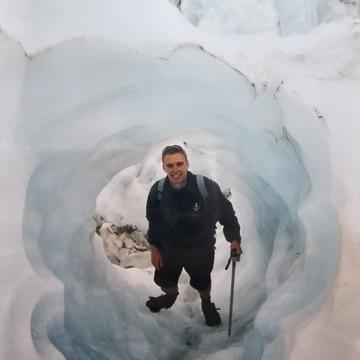
In Franz Josef Glacier during his 2004 trip to New Zealand
What is the proudest achievement in your career so far?
I think probably when I was starting my DPhil and I was initially trying to measure T-cells, and needed to prove that the techniques were going to work. To do this we added some precious metals like rhodium and iridium to the cells, which we knew wouldn’t normally be present, but the measurements just weren’t working. There were significant logistical challenges in having to bring the cells down the hill from the hospital to the Department to be measured. I would spend ages preparing them and then cycle them down here, only to find that they had died en-route. There were numerous occasions that occurred! However, we eventually refined the procedure and got it working: seeing that first measurement come through was so exciting. Overcoming all those failed experiments and getting data that was coming through correctly was just the best.
I need to know how you achieved that! Was it just a case of cycling faster down the hill?
I have a fold up bike – and it turns out it’s a little rickety coming down the hill. I started by avoiding the cattle grids behind Linacre College, and then I also adopted a rucksack I use for running, which worked really well because it sits snugly on your back and there’s a little hydration pouch that fits the cells perfectly. So, it turns out adapting my research based on my sporting hobbies was the solution!
What developments in analytical methods do you think will happen in the next decade?
Over the last 10 or 20 years, ICP-MS has evolved from really big instruments taking up a whole lab, to a much more compacted versions. Indeed, a great deal of effort has been made to miniaturise such instruments so they have a smaller footprint, which is quite a challenge for mass spectrometry because there's a lot of workings and mechanics inside. But the other goal has been to lower the detection limits to be able to measure these trace elements down to such low levels. This has been a target for many environmental and pharmaceutical applications, but in research it's also really vital to be able to measure some of these trace elements at high accuracy and really low levels. So going forward, it's no longer about miniaturising the instrument, it's miniaturising what we can measure – tiny quantities in cells and nanoparticles. Microplastics, for example, are also becoming more common in our rivers and oceans, and our drinking water, so being able to measure these tiny particles accurately in the future is pretty important.
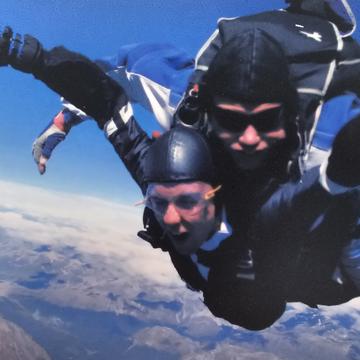
Skydiving in Queenstown, New Zealand
Are there any little-known pioneers in your field that you would like to highlight?
Aside of my DPhil supervisors (Jon and Hal), the person I look up to most is my masters tutor, Dr Bill Perkins, who is a real pioneer in the field of analytical chemistry, and really got me to enjoy that side of the subject. Additionally, I would also like to highlight the technicians here at Oxford. Last year I attended the Oxford Technicians Seminar, which is an annual event showcasing data output and research conducted by many technicians from different small research facilities throughout the university. It captured some of the amazing outputs that are going on in the different fields of science, and showed that the technicians are important cogs within the research landscape here.
What motivates you as a researcher?
It’s exploring the unknown. That I get to come in every day and try to overcome the limitations of the technique and measure challenging samples. These are the things that really excite me and encourage me to push the frontiers of mass spectrometry. There are instruments where we can measure trace metals in seawater down to nanomolar or picomolar levels, or even the attogram level when we’re measuring cells, which is 10-18 (billionth of a billionth of a gram), and we aren’t even really pushing the mass spec that hard!
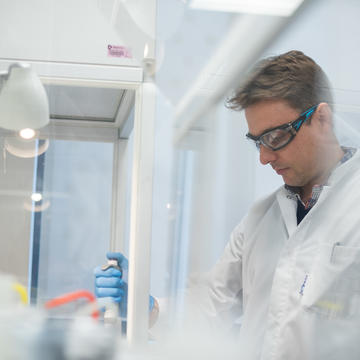
What’s your favourite piece of fiction that involves Earth Sciences?
I really enjoy the Ice Age movies! I also saw a film a while ago called the Wave, which was a bit more serious, but still a cool film, about a tsunami disaster. In terms of music, I generally like to listen to pop music when I’m doing my work, and I like Titanium by David Guetta and Sia because that has a link to the periodic table!
What are you currently working on?
To further our work on T-cells, we really want to further interrogate trends of iron uptake in cells – both amongst and between cell populations. So far, we have managed to measure iron levels in cultured cells, but that doesn’t provide enough detail to explain how much was present in the first place and how much was uptaken. One way to do this is to use a stable isotope of iron that has a miniscule abundance in nature. If we add that in as part of the experiment and can quantify how much of each isotope is present in the cell, we can then gauge exactly how much of the iron was taken up. That's really key to moving on to the next stage, which is to understand if there are certain cells, or subsets of cells, that are taking up the iron over others. A lot of the work that's been done to understand anaemia has been taking bulk cells and then measuring an average of your iron levels, which is great. But, when we're looking at what's occurring down at the atomic level in cells, there's so much heterogeneity going on, which needs to be understood.




